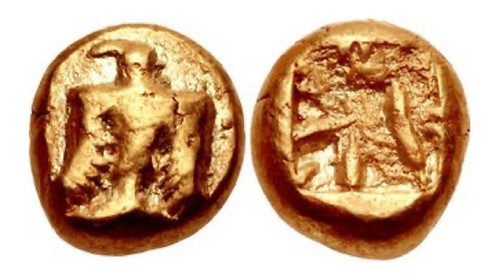
PREV ARTICLE
NEXT ARTICLE
FULL ISSUE
PREV FULL ISSUE
EAGLES ON ANCIENT COINSIn his latest CoinWeek Ancient Coin Series article, Mike Markowitz looks at eagles on ancient coins. Here's a short excerpt - see the complete article online. -Editor
Majestic, powerful, swift, and intelligent, the eagle has held a strong grip on human imagination since the earliest times. The bald eagle, native to North America, features prominently on the Great Seal of the United States, and on many classic and modern American coins. The U.S. $10 gold piece was called an
The golden eagle (Aquila chrysaetos), native to the Old World, is frequently seen on ancient coins. A search for the term
Ionia IONIA, Uncertain. Circa 600-550 BCE. EL Hekte – Sixth Stater(?) (8mm, 1.86 g). Uncertain standard. Eagle flying upward, head left / Incuse square with two parallel right angle lines within. CNG E-408, lot 197 var. (lines in rev. punch); Rauch Summer Auction 2012, lot 345 var. (plain punch); otherwise unpublished. Good VF, as made. Extremely rare. Credit: CNG
The earliest appearance of an eagle on a coin dates from about 600-550 BCE: an electrum hekte (or
Olympia Elis, Olympia Stater circa 450-440, 82nd-87th Olympiad, AR 12.38 g. Eagle flying r., grasping hare with its talons and tearing at it with its beak. Rev. Nike running l., holding wreath in extended r. hand and l. raising hem of chiton; in the field, F – A. All within incuse circle. Seltman 69 (AN/at?). Gillet 965 (this coin). SNG Copenhagen 358 (these dies). SNG Spencer-Churchill 165 (this coin). Credit: Numismatica Ars Classica The city of Elis in Greece managed the sacred site of Olympia, where the Olympic games were held every four years beginning in 776 BCE. Foreign coins were not accepted at the games, so visitors had to exchange their money for special issues that produced a tidy profit for Elis. For about two centuries, Elis maintained a high standard of artistry on this coinage, which often included an eagle, the companion of Zeus. A lifelike eagle in flight, grasping a hare in its talons and tearing it with its beak appears on a coin of Elis, struck c. 450-440 BCE and pedigreed to the famous Spencer-Churchill collection, realized over $32,000 USD in a 2019 Swiss auction.
To read the complete article, see:
Wayne Homren, Editor The Numismatic Bibliomania Society is a non-profit organization promoting numismatic literature. See our web site at coinbooks.org. To submit items for publication in The E-Sylum, write to the Editor at this address: whomren@gmail.com To subscribe go to: https://my.binhost.com/lists/listinfo/esylum All Rights Reserved. NBS Home Page Contact the NBS webmaster 
|


